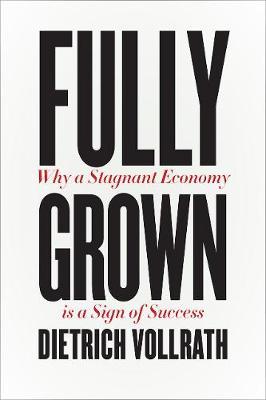Fully grown
why a stagnant economy is a sign of success
- ISBN: 9780226666006
- Editorial: University of Chicago Press
- Fecha de la edición: 2020
- Lugar de la edición: Chicago. Estados Unidos de Norteamérica
- Encuadernación: Cartoné
- Medidas: 23 cm
- Nº Pág.: 260
- Idiomas: Inglés

Most economists would agree that a thriving economy is synonymous with GDP growth. The more we produce and consume, the higher our living standard and the more resources available to the public. This means that our current era, in which growth has slowed substantially from its postwar highs, has raised alarm bells. But should it? Is growth actually the best way to measure economic success--and does our slowdown indicate economic problems?
The counterintuitive answer Dietrich Vollrath offers is: No. Looking at the same facts as other economists, he offers a radically different interpretation. Rather than a sign of economic failure, he argues, our current slowdown is, in fact, a sign of our widespread economic success. Our powerful economy has already supplied so much of the necessary stuff of modern life, brought us so much comfort, security, and luxury, that we have turned to new forms of production and consumption that increase our well-being but do not contribute to growth in GDP.
In Fully Grown, Vollrath offers a powerful case to support that argument. He explores a number of important trends in the US economy: including a decrease in the number of workers relative to the population, a shift from a goods-driven economy to a services-driven one, and a decline in geographic mobility. In each case, he shows how their economic effects could be read as a sign of success, even though they each act as a brake of GDP growth. He also reveals what growth measurement can and cannot tell us--which factors are rightly correlated with economic success, which tell us nothing about significant changes in the economy, and which fall into a conspicuously gray area.
1. Victims of Our Own Success
2. What Is the Growth Slowdown?
3. The Inputs to Economic Growth
4. What Accounts for the Growth Slowdown?
5. The Effect of an Aging Population
6. The Difference between Productivity and Technology
7. The Reallocation from Goods to Services
8. Baumol’s Cost Disease
9. Market Power and Productivity
10. Market Power and the Decline in Investment
11. The Necessity of Market Power
12. Reallocations across Firms and Jobs
13. The Drop in Geographic Mobility
14. Did the Government Cause the Slowdown?
15. Did Inequality Cause the Slowdown?
16. Did China Cause the Slowdown?
17. The Future of Growth







